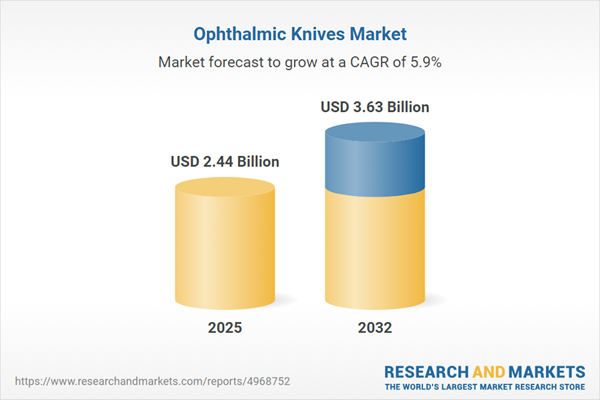Speak directly to the analyst to clarify any post sales queries you may have.
The ophthalmic knives market is advancing rapidly, driven by evolving surgical needs and ongoing innovation in precision medical instruments. This research offers a comprehensive overview of current and emergent trends shaping the segment, providing strategic insight for senior decision-makers evaluating opportunities in ophthalmic surgical technologies.
Market Snapshot: Growth Trajectory of the Ophthalmic Knives Market
The ophthalmic knives market grew from USD 2.30 billion in 2024 to USD 2.44 billion in 2025. It is expected to continue growing at a CAGR of 5.86%, reaching USD 3.63 billion by 2032. Several forces are propelling this expansion, including technological advancements in blade materials and geometry, growing adoption of minimally invasive eye surgeries, and strict regulatory benchmarks emphasizing patient safety and instrument reliability. Across the Americas, Europe Middle East & Africa, and Asia Pacific, established medical infrastructures, rising healthcare investments, and increased awareness of vision correction procedures fuel demand. This environment creates opportunities for both international and regional suppliers as the market adapts to changing clinical and economic dynamics.
Scope & Segmentation: Structure of the Ophthalmic Knives Market
- Blade Edges: Double bevel and single bevel designs, each influencing incision performance and wound healing.
- Materials: Carbon steel, stainless steel, and tungsten carbide, allowing for varying balances of durability, cost, and cutting characteristics.
- Usage Patterns: Disposable and reusable models, with trade-offs between sterility assurance and sustainability.
- Surgical Applications:
- Cataract surgery (femto laser, manual small incision, phacoemulsification)
- Corneal surgery (lamellar and penetrating keratoplasty)
- Glaucoma surgery (trabeculectomy, tube shunts)
- Refractive surgery (LASIK, PRK, SMILE)
- Vitrectomy (anterior, posterior)
- End Users: Ambulatory surgical centers, clinics, and hospitals, each with varying procurement needs and procedural volumes.
- Sales Channels: Direct sales and distribution, each playing a role in access, after-sales support, and regulatory compliance.
- Regions: Americas (North and Latin America), Europe, Middle East & Africa (including subregions and key countries), and Asia-Pacific (China, India, Japan, and others).
- Key Companies: Alcon Incorporated, Johnson & Johnson Vision Care, Inc., Bausch & Lomb Incorporated, Hoya Corporation, MANI, Inc., Moria SA, Diamatrix Ltd., Sidapharm, Corza Medical GmbH, Ophtechnics Unlimited.
Key Takeaways: Strategic Insights for Decision Makers
- Demand for minimally invasive ophthalmic procedures is prompting development of advanced instruments that deliver consistent, low-trauma incisions and align with evolving surgical protocols.
- Adoption of eco-friendly materials and innovative blade coatings is supporting both surgical performance and organizational environmental objectives.
- Manufacturers are strengthening supply chains and pursuing regional production strategies to address volatility in logistics and raw material sourcing.
- Quality management and regulatory compliance are central, with enhanced documentation and traceability measures being integrated into operational processes.
- Surgeons’ feedback and clinical partnerships are shaping ongoing product refinement, ensuring that evolving procedural requirements are met.
- Strategic alliances, portfolio diversification, and technology partnerships are giving leading brands a competitive edge within precision surgery markets.
Tariff Impact: Navigating Market Shifts in 2025
Recent tariff adjustments have increased pressure on material costs, prompting shifts in sourcing and manufacturing strategies. Nearshoring and localized production have emerged as effective responses, improving supply chain resilience and reducing lead times. Standardization of blade specifications and realignment of pricing strategies are supporting organizational margins and ensuring continued access to critical surgical instruments.
Methodology & Data Sources
This report combines thorough secondary research, including a review of regulatory filings and industry publications, with structured interviews involving surgeons, procurement specialists, and engineers. Findings are triangulated through both qualitative insights and quantitative data, offering a rigorous perspective on historical and recent market trends.
Why This Ophthalmic Knives Market Report Matters
- Guides senior executives in product strategy, market entry, and investment decisions by detailing technology trends and evolving clinical needs.
- Enables operational teams to benchmark against competitors and anticipate the impact of regulatory and tariff changes on procurement and supply chains.
- Delivers actionable intelligence for regional expansion and portfolio alignment, supporting sustainable growth in changing market conditions.
Conclusion
Senior decision-makers accessing this market intelligence can align with emerging surgical, regulatory, and economic shifts. Enhanced collaboration and ongoing innovation will be essential to sustaining growth, improving clinical outcomes, and meeting dynamic healthcare demands.
Additional Product Information:
- Purchase of this report includes 1 year online access with quarterly updates.
- This report can be updated on request. Please contact our Customer Experience team using the Ask a Question widget on our website.
Table of Contents
3. Executive Summary
4. Market Overview
7. Cumulative Impact of Artificial Intelligence 2025
List of Figures
Samples

LOADING...
Companies Mentioned
The key companies profiled in this Ophthalmic Knives market report include:- Alcon Incorporated
- Johnson & Johnson Vision Care, Inc.
- Bausch & Lomb Incorporated
- Hoya Corporation
- MANI, Inc.
- Moria SA
- Diamatrix Ltd.
- Sidapharm
- Corza Medical GmbH
- Ophtechnics Unlimited
Table Information
| Report Attribute | Details |
|---|---|
| No. of Pages | 196 |
| Published | October 2025 |
| Forecast Period | 2025 - 2032 |
| Estimated Market Value ( USD | $ 2.44 Billion |
| Forecasted Market Value ( USD | $ 3.63 Billion |
| Compound Annual Growth Rate | 5.8% |
| Regions Covered | Global |
| No. of Companies Mentioned | 11 |









